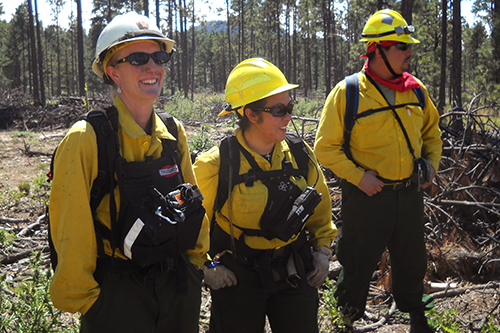
Natural resources management graduate student Elyssa Durí¡n, center, waits for a briefing at an international prescribed burn training in the Jemez Mountain of New Mexico. Sara Brown, a Highlands forestry professor, is at the left and Mauricio Herní¡ndez, a forest ranger from Costa Rica, is at the right.
Las Vegas, NM — Elyssa Durí¡n of Highlands University was the only student and the youngest person to work the fire line when resource managers and firefighters from across the globe came to New Mexico for a prescribed burn training.
Durí¡n, 24, a natural resources management graduate student, spent two weeks in the Jemez Mountains in September as part of a Spanish language prescribed fire training exchange, or TREX. Trainees came from Mexico, Spain, Argentina, Costa Rica, Guatemala, and other countries.
“Elyssa has helped as part of our international TREX cadre for the past three years, and her experience, education and background add important value to our training,” said Jeremy Bailey, fire training coordinator for The Nature Conservancy. “She is bilingual and has the forestry education to help us identify and understand the ecological role of fire in New Mexico’s forests.”
The TREX international training is by invitation only. The Nature Conservancy, U.S. Forest Service, and The Fire Learning Network sponsor the event.
Durí¡n also monitored weather conditions like humidity and wind, transmitting them in Spanish to the burn leaders.
“The exchange of information among the different nationalities was fascinating and gave me insight into fire management practices and policy in different countries,” Durí¡n said. “What surprised me the most is that in some countries, like Argentina, prescribed burns aren’t allowed and are punishable by law.”
Durí¡n said the field experience was invaluable.
“I want to be a forester who uses fire to manage land and conserve natural resources for future generations. Carrying out every aspect of a prescribed burn from planning to implementation was exciting,” Durí¡n said.
The Cuba, New Mexico native earned her B.S. with honors from Highlands in 2013 with a double major in forestry and Spanish. Durí¡n also presented her thesis research topic in Spanish at the prescribed burn training.
“The goal of my study is to evaluate soil health before and after prescribed fires that use masticated fuels — chipped forest trees — rather than piles of slash from tree thinning,” Durí¡n said. “I’m measuring soil moisture and soil infiltration, which is how water percolates into the soil. Soil moisture affects plant regeneration after fires.”
Durí¡n is conducting her study on three ecosystems, including chaparral, ponderosa pine, and piñon-juniper. Her study sites are in Ruidoso, New Mexico as well as Prescott and Payson in Arizona.
“It’s really important for federal agencies to hire young professional foresters like Elyssa who are well trained in using prescribed burns and advocate for using this method to maintain forest health,” said Sara Brown, a forestry professor at Highlands and Durí¡n’s thesis adviser.
Brown participated in the exercise for one day and also gave a talk about the principles of fire ecology in the western United States. She was a wildland firefighter for 11 seasons with the U.S. Forest Service before earning her Ph.D. in ecology from the University of Wyoming.
“Elyssa’s thesis research is very significant for understanding how prescribed fire will affect the soil health under different fuel treatment options such as chipping,” Brown said. “Elyssa is a very dedicated, focused and intelligent researcher. She’s going to be an excellent forest manager who is well prepared to make strategic management decisions.”
Highlands is the only college in New Mexico to offer a forestry degree that is accredited by the Society of American Foresters.
“The research and field opportunities in forestry and natural resources management at Highlands are second to none,” Durí¡n said.
